5 Steps to Giving a Great Conference Talk
When Steve Jobs presented the iPhone for the first time, he didn’t get up on stage and say, “Hey this is an iPhone.” Instead, he told a story – specifically the story of Apple. He built up the iPhone in terms that people understood. This made for an excellent presentation. It sucked people in, it made them invested in what it was talking about, and ultimately, he announced the iPhone to huge cheers. Steve Jobs knew how to give a great presentation.
Now, I’ve been speaking in front of people for a long time. My first on stage performance was at 7 years old, when I was in 2nd grade. I love being in front of people, whether I’m acting, teaching, or just talking. But giving a good conference presentation takes practice. After professionally speaking for almost 10 years, I know what works and what needs work. Here are my 5 steps to putting together a good conference talk.
Step 1: Tell a Story
My friend Chris Lemaknows how to give a good conference talk. He also starts ofmostof what he says with, “Let me tell you a story.” He then regales us with an interesting, relatable story that grabs our attention. That’s your goal too: start off your presentation by grabbing the attention of your attendees.
[bctt tweet=”Start your talk by telling a story. ” username=”jcasabona”]
Here’s the honest truth: unless you’re a HUGE name in the community for the conference you’re speaking at, most people are probably more interested in your talk topic than in who you are. It’s for that reason that you don’t want to start off your talk with an introduction. “Hi I’m Joe Casabona,” is telling people something they already know, based on the schedule. It’s also not very interesting. Finally, it doesn’t tell them anything about what they’re going to learn at the talk.
Instead, pick a story that will draw your attendees in. Make it interesting, and importantly, make it related to what you’re talking about. At a recent talk I gave, I started with how George Washington used the Fabian tactic against the British in the American Revolution. I’m giving folks a simple fact about a topic they likely know and care about. But why am I telling them this?
Step 2: Give the Reason for Your Story
I was telling that particular story because I was talking about the importance of having a plan. Washington clearly had a plan and it worked out for the Americans long enough to get the French involved and win the war. I concluded my story with as much: “George Washington knew the importance of having a plan.”
Stories are fun but they aren’t the reason someone is watching your conference talk (most likely). The talk I gave was called,How I Built It: An Online Learning Website with WooCommerce.George Washington seems like the least qualified person to talk about this for several reasons, including the internet was -200 year old when he was born. But my point was that it’s important to have a plan, something Washington knew a lot about. The reason, however you add it into your story, gives you the segue you need to get to the bulk of your talk.
Step 3: State Your Problem
Your conference talk should have a focused and clearly defined point. Now that you’ve set up your problem with your story, it’s time to state it explicitly. The problem I gave during my talk was: “I didn’t have a plan when I started WordPress in One Month.”
[bctt tweet=”State your problem for your audience. ” username=”jcasabona”]
Once you state the problem, you can build the rest of your talk around it. And stating it explicitly means there’s no confusion among your attendees.
Step 4: Give Actionable Advice (or Solve Your Problem)
With our problem clearly defined, it’s time to solve it through actionable advice. I will try to give one-sentence solutions or quips to help attendees remember, or write down, what they are learning. Keep in mind that your attendees are seeing multiple talks so you want your takeaways to be short and memorable.
Mine were about the willingness to change directions as I needed to, understanding what I was doing in-order to come up with a solid plan, and a few useful tools I became familiar with.
[bctt tweet=”Solve your problem with short, memorable advice for your audience.” username=”jcasabona”]
Step 5: Tell Them Who You Are
NOW it’s time to tell them who you are. Hopefully by this point, you’ve won your attendees over by entertaining them with a story and giving them great advice. They want to know who you are so they can keep up with you and possibly ask follow-up questions. I always end my talks with, “I’m Joe Casabona, a developer and teacher. You can find me at @jcasabona on most social networks.”
Be Yourself!
It’s worth noting that we all have different personalities and styles. This is a framework that works really well for me. I’m able to tell a good story I know, pepper in some jokes, give good advice, and leave my attendees with some personal insight. You should do what works for you – tweak or change as needed! Or even better, if you do give conference talks, let me know your best advice in the comments!
[bctt tweet=”Most importantly, be yourself!” username=”jcasabona”]


